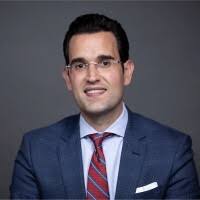Auto dealer executive Eric Frehsée has concerns about the battery-electric-vehicle (BEV) market.
But he’s sold on plug-in hybrid electric vehicles (PHEVs)
“I’m a big believer in plug-ins,” says the president of the Tamaroff Auto Group based in metro Detroit.
BEVs run strictly on battery power. PHEVs rely on a dual-propulsion system. They use electricity until the battery is depleted, then switch to gasoline mode for longer drives, such as a road trip.
“It’s the way to go,” Frehsée (pictured, below left) says of PHEVs. “It’s truly a much easier transition to full-electric vehicles.”
 The U.S. government is spurring a big switch from internal-combustion-engine (ICE) vehicles to BEVs, often simply referred to as EVs or electric vehicles. The government is picking up the pace of its electrification mandates.
The U.S. government is spurring a big switch from internal-combustion-engine (ICE) vehicles to BEVs, often simply referred to as EVs or electric vehicles. The government is picking up the pace of its electrification mandates.
Newly proposed EPA emissions standards call for 67.5% of BEVs to account for new-vehicle sales by 2032.
The National Automobile Dealers Assn. bridles at that timetable, although it notes dealers aren’t necessarily anti-BEV.
“America’s franchised dealers have invested $6 billion in EV infrastructure,” says NADA President and CEO Mike Stanton. “While we share the goal of lowering greenhouse gas emissions, the EPA’s proposed rule goes too far too fast.”
J.D. Power says BEVs remain in an “early-adopter phase, with sales accounting for 8.2% of the new-vehicle market through October. The market-research firm projects BEVs will hold 13% of the market by the end of 2024 and have a 24% total market share by 2026.
Cox Automotive predicts sales of fully electric vehicles will reach a record 1 million this year. But despite several years of annual sales increases, supply is beginning to outpace demand.
Frehsée expresses concern about BEVs during an online media program that includes Martin French, a partner with Berylls Strategic Advisors.
“I really don’t think we’ll get to 100%,” Frehsée says of ultimate BEV sales.
At least not in his market, where his dealer group represents Honda, Acura, Nissan and Kia. “We’re in Detroit, the Motor City, where people love engines. We don’t have people knocking down the dealership doors to buy EVs.”
He calls federal mandates misguided. “Whenever government tries to push consumers, it hasn’t been successful. Let the transition to EVs be more natural than enforced, he says.
French agrees, saying, “People don’t like things imposed upon them.”
They note some manufacturers that offer PHEVs – 33 models are available in the U.S. – are increasing their production.
At the same time, many automakers are cutting back on BEV production as consumer demand, while growing, hasn’t met expectations.
For example, Ford has curtailed production of its F-150 Lightning EV pickup. New output schedules call for building about 1,600 units a week, down from about 3,200 that had been planned earlier.
“EVs have the highest inventories on dealer lots,” Frehsée says.
Still, EV sales are increasing at a faster rate than PHEVs.
Wards Intelligence reports BEVs accounted for 747,982 deliveries in the U.S. out of 13.7 million vehicles sold in 2022. That’s an increase of 288,558 units over 2021.
In contrast, PHEV sales were 183,441 in 2022, up slightly from 176,117 the year before, Wards reports.
Many dealers are enthusiastic about selling BEVs, but those unsold units on their lots are giving them pause.
“Manufacturers are realizing the demand isn’t there as much as they thought,” Frehsée says, adding that some dealers are giving BEV buyers free home chargers as an incentive.
To which French says, “That’s not a sustainable business model, is it?”
He adds: “Dealers and their salespeople have to be able to make a living selling EVs.”
BEVs represent a different, longer type of transaction because sales staff must field a wider range of customer concerns and questions.
Reasons consumers are balking at buying BEVs include lack of charging station availability; time required to charge; limited driving distance; and inadequate performance during temperature extremes.
“No doubt, a lot of consumers are interested in EVs, but they see challenges in turning over the keys of their ICE vehicle for an EV,” Frehsée says, adding that PHEVs allow them to “put their toe in the water.”





